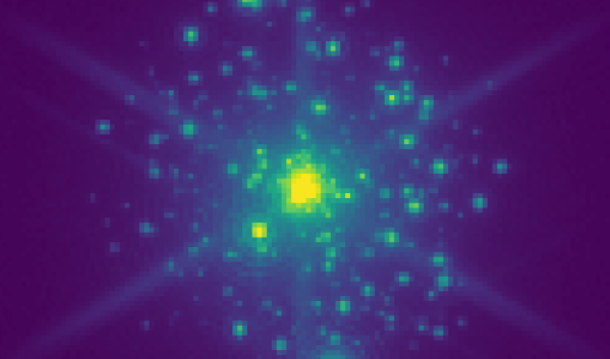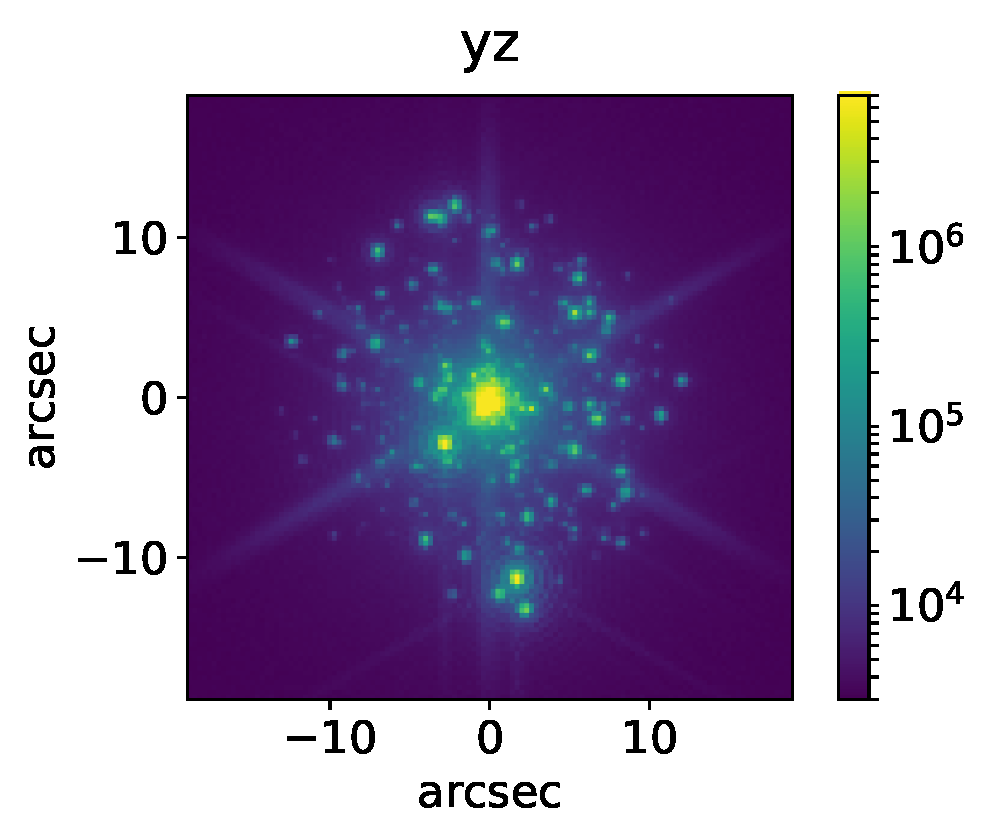(English follows Dutch)
Als twee sterrenstelsels botsen, smelten hun centrale zwarte gaten samen waarbij ze zwaartekrachtgolven uitzenden. Volgens de theorie zorgt een terugslageffect er soms voor dat het versmolten zwarte gat uit het sterrenstelsel wordt gestoten en de sterren in zijn buurt meesleurt. Onderzoekers van SRON en de Radboud Universiteit hebben nu een voorspelling gemaakt van hoe deze clusters eruit zullen zien in een database, zodat we ze kunnen identificeren en hun bestaan kunnen bewijzen. Publicatie in MNRAS.

Astronomen denken dat alle zware sterrenstelsels een zwart gat in hun centrum herbergen met een gewicht van miljoenen tot miljarden zonsmassa’s. Dwergstelsels hebben mogelijk een kleiner zwart gat in hun kern. Het bekendste centrale zwarte gat is dat van M87, dat in 2019 wereldfaam verwierf door het eerste gefotografeerde zwarte gat ooit te worden. Als twee sterrenstelsels fuseren, mixen hun sterren veelal door elkaar zonder te botsen, maar de twee centrale zwarte gaten smelten samen. Dat produceert zwaartekrachtgolven die extreme hoeveelheden energie afgeven, vergelijkbaar met een atoombom met de massa van meerdere zonnen. Je kunt je voorstellen dat als deze energie zelfs maar een klein beetje asymmetrisch wordt uitgestraald, er een terugslag in de andere richting zal zijn, vergelijkbaar met een astronaut die een pistool in de ruimte afvuurt. Als de terugslag sterk genoeg is, wordt het resulterende versmolten zwarte gat uit zijn eigen sterrenstelsel gestoten. Alle sterren die eraan zijn verbonden via de zwaartekracht worden meegesleurd. Zo ontstaan hypercompacte stellaire clusters (HCSCs). Althans volgens de theorie; ze zijn nooit in het echt gezien.
Een groep astronomen van SRON Netherlands Institute for Space Research en de Radboud Universiteit bedacht dat HCSCs mogelijk al verscholen zitten in bestaande databases, waaronder die van de Gaia-ruimtetelescoop en de Sloan Digital Sky Survey. Maar ze kwamen er al snel achter dat niemand voorspellingen had gedaan met voldoende detail over hoe ze eruit zouden zien in de database. Dus als eerste stap in hun zoektocht hebben ze nu hun eigen voorspellingen gedaan en gepubliceerd in de Monthly Notices of the Royal Astronomical Society. Het team—waaronder eerste auteur Davide Lena en groepsleider Peter Jonker—voorspelt onder meer de kleuren en spectra van HCSCs, specifiek op maat gemaakt voor elke database. Ze berekenden ook hoe een cluster eruit zou zien op een tweedimensionale telescoopafbeelding.
Als de onderzoekers erin slagen om de eerste echte HCSC te identificeren, kunnen ze de snelheid afleiden die hij kreeg van de terugslag na de fusie van de twee sterrenstelsels waar hij uit is ontstaan. Lena: ‘Dat is al berekend vanuit simulaties aan zwaartekrachtgolven, maar die zijn gebaseerd op theorieën die we nog moeten testen via waarnemingen.’
Alle versmolten zwarte gaten aan de rand van de Melkweg zullen het resultaat zijn van fusies tussen een dwergstelsel en een jonge versie van de Melkweg die toen net helemaal opnieuw was begonnen met het bouwen van een groot centraal zwart gat. Dus die hebben op zijn hoogst een middelzware massa; tussen honderden en honderdduizenden zonsmassa’s. ‘Er is discussie over het bestaan van middelzware zwarte gaten,’ zegt Lena. ‘Als we inderdaad HCSCs vinden, bewijzen we tegelijkertijd het bestaan van middelzware zwarte gaten. We kunnen dat dan bevestigen door de massa van de zwarte gaten te meten via het spectrum van de HCSC.’
Jonker: ‘We denken dat samensmeltingen een belangrijke rol spelen in de vorming van zware zwarte gaten. De LISA-satelliet, die ESA in 2034 lanceert, moet de zwaartekrachtgolven kunnen detecteren die zulke fusies produceren. Onder meer SRON en Radboud staan klaar om daaraan mee te bouwen.’
Publicatie
D. Lena, P. G. Jonker, J. P. Rauer, S. Hernandez and Z. Kostrzewa-Rutkowska, ‘Hypercompact stellar clusters: morphological renditions and spectrophotometric models’, Monthly Notices of the Royal Astronomical Society

Astronomers make composition drawing of elusive wandering black holes
When two galaxies collide, their central black holes merge emitting gravitational waves. Astronomers theorize that a recoil effect sometimes kicks the merged black hole out of the galaxy while dragging nearby stars along for the ride. Researchers from SRON and Radboud University have now made a prediction of what these clusters will look like in a database, so that we can identify them and prove their existence. Publication in MNRAS.

Astronomers think that all massive galaxies harbor a black hole in their center, weighing millions to billions of solar masses. Smaller black holes might be present in the nuclei of dwarf galaxies. The most famous central black hole is the one inside the M87 galaxy, which became the first ever photographed black hole in 2019. When two galaxies merge, their stars will mostly just mingle without colliding, but the two central black holes will merge. The merger produces gravitational waves carrying off extreme amounts of energy, comparable to an atomic bomb with the mass of several suns. You can imagine that if this energy is radiated even slightly asymmetrically, there will be a recoil in the other direction, similar to an astronaut firing a gun in space. If the recoil is strong enough, the resulting merged black hole is ejected out of its own galaxy. Any stars that were gravitationally bound to it, will be tugged along for the ride. This is how hypercompact stellar clusters (HCSCs) arise. At least according to theory; they have not yet been spotted in real-life.
A group of astronomers from SRON Netherlands Institute for Space Research and Radboud University figured that HCSCs might be hidden in existing databases, including those from the Gaia telescope and the Sloan Digital Sky Survey. But they quickly realized that no-one has made any detailed-enough predictions about what they would look like in the database. So, as a first step in their quest, they have now made their own predictions and published them in the Monthly Notices of the Royal Astronomical Society. The team—including first author Davide Lena and group leader Peter Jonker—predict the colors, images and spectra of HCSCs specifically tailored for each database. They also calculated how a cluster would appear on a two-dimensional telescope image.
If the researchers manage to identify the first real-life HCSC, they can derive the kick velocity that it received from the recoil following the merger of the two galaxies it emerged from. Lena: ‘That has already been calculated from simulations of gravitational waves, but those are based on theories that need to be confirmed by observations.’
Any ejected black holes in the Milky Way’s outskirts will have been the result of mergers between a dwarf galaxy and a young Milky Way that had recently started from scratch with building a massive black hole in its center. So those merged black holes should be of no more than intermediate mass; between hundreds and hundreds of thousands of solar masses. ‘The existence of intermediate mass black holes is debated,’ says Lena. ‘If we indeed find HCSCs, we will at the same time show the existence of intermediate mass black holes. We can then confirm this by measuring the mass of the black holes through spectroscopic observations of the HCSC.’
Jonker: ‘We think that mergers play an important part in forming massive black holes. ESA’s LISA satellite, to be launched in 2034, will be able to detect their gravitational waves. Among others SRON and Radboud University are set to contribute to building this fantastic satellite.’
Publication
D. Lena, P. G. Jonker, J. P. Rauer, S. Hernandez and Z. Kostrzewa-Rutkowska, ‘Hypercompact stellar clusters: morphological renditions and spectrophotometric models’, Monthly Notices of the Royal Astronomical Society



